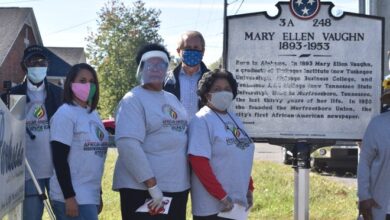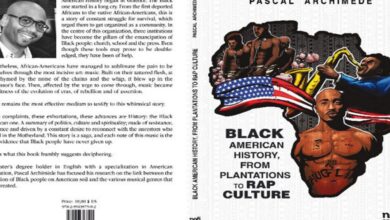Discover the history of Tennessee’s forgotten music empire

Travelers—and history fans—may have heard of Black music meccas such as Bourbon Street in New Orleans and Beale Street in Memphis. But Chattanooga, Tennessee’s Martin Luther King, Jr. Boulevard, formerly known as Ninth Street or “The Big Nine,” once buzzed with clubs hosting blues, jazz, and R&B legends. They included hometown starlet Bessie Smith, known as the “The Empress of the Blues,” Lovie Austin, one of the first Black female bandleaders in the 1920s, and James Brown’s funky drummer, Clyde Stubblefield.
Legendary blues singer Bessie Smith was born in Chattanooga in 1894. Her career started by busking on the corners of Ninth Street with her brother to help support their family. Photo by Gilles Petard, Redferns/Getty Images
“It was the heart of the Black community,” says Elijah Cameron, the director of community relations at the Bessie Smith Cultural Center, an African American history museum and community events space in the neighborhood. “We took Ninth Street and made it a jewel.”
From its boom years in the early 20th century, the destruction of the Big Nine was a gradual one. Its rich history slowly washed away across many decades due mainly to urban renewal. Still, its spirit lives on via brightly colored murals, like the M.L. King Mural—the largest of its kind in the Southeastern United States—and the “Big 9 Legends” panorama—featuring musicians whose sounds were once the musical soul of the city. These and other downtown Chattanooga destinations provide a glimpse of this once vibrant African American community and offer signs of what city activists hope will be its revival.
Rise of the Big Nine
From the late 1800s to the late 1960s, the five-block stretch of Chattanooga’s Ninth Street bustled with dozens of Black-owned movie theaters, grocery stores, and nightclubs, earning it the nickname “the Big Nine.” (It was renamed M.L. King Boulevard in 1981.)
In 1870, John Lovell, a local civic leader and businessman, set up the first Black-owned business in Chattanooga under a tent at the corner of Ninth Street and Georgia Avenue, selling whiskey and running a prostitution ring. Lovell prospered, and by the early 1900s, he built Mahogany Hall, a block of three-story buildings that housed a hotel, dance hall, restaurants, a casino, and saloons. This fueled Ninth Street’s rise as a vibrant Black entertainment and business community, which lasted until the 1960s.
“A lot of Lovell’s saloon activity was contested within the Black community about it being vice-ridden and not respectable,” says historian Michelle R. Scott, author of the Bessie Smith biography, Blues Empress in Black Chattanooga. “Yet, he turned a good deal of his profit from Mahogany Hall into building up Ninth Street. By 1910, there were 155 Black residents and [several] shops on Ninth Street.”
Chattanooga’s Ninth Street became a national hub for blues and jazz music in the post WWII era until the late 1960s. After playing to segregated crowds, artist like Ella Fitzgerald and James Brown would head to the bars on the Big Nine to perform with local talent. Photograph courtesy of The Bessie Smith Cultural Center
From the 1920s until the late 1960s, Black musicians including Cab Calloway, Ella Fitzgerald, Curtis Mayfield, James Brown, Martha and the Vandellas, and Jimi Hendrix would play to packed crowds at the dozens of clubs lining the street and at the nearby, then segregated Soldiers and Sailors Memorial Auditorium.
(From bluegrass to blues, here’s where to experience the music of the American South.)
Blues singer Bessie Smith was born in Chattanooga in 1894, in a small, mostly Black neighborhood on Ninth Street called Blue Goose Hollow. She would sing on street corners for change to support her family but left at age 18 to join a traveling vaudeville troupe where she sang alongside blues legend Ma Rainey before later becoming an icon herself.
Learn more about Smith and other famous Black musicians at the Bessie Smith Cultural Center, which underwent significant renovations in 2021. Located where the historic Martin Hotel—the largest, most luxurious Black-only hotel in the South—once stood, the museum and performance venue features vintage photos and videos, interactive displays, and reproductions of old Ninth Street businesses like Renewal Barber Shop—which was considered to be a safe meeting place for Black men to chat about what was going on in the community. There’s also a cache of Smith’s belongings including her piano and some original photos.
“For you to understand how and why things are the way they are, you have to look to history for answers,” says Cameron. “It not only reveals the past, but it also helps us create a better future.” This unique history is what led Ninth Street to be added to the National Register of Historic Places in 1994.
A 15-minute walk away in the Southside district, Songbirds Guitar & Pop Culture Museum has a new exhibit on the Big Nine which includes a short documentary on those who lived and played on Ninth Street, a pair of Clyde Stubblefield’s drumsticks, a replica of a dress worn by Bessie Smith, as well as a pair of blue shoes owned by Fred Cash of the Impressions. Plans for an oral history project for others to tell their stories about the Big Nine are in the works for later this year.
Reviving a neighborhood
Today, there is just a smattering of historic Black businesses that remain of the former Big Nine. Live and Let Live Barber Shop, which opened in 1931, Jackson Service Station, which has been in operation since the 1930s, the 100-year-old Olivet Baptist Church, are among them.
R.I.S.E., an independent minority-led organization in Chattanooga, leads a 90-minute Big Nine walk tour to educate residents and tourists about the significance Ninth Street played in Chattanooga’s history.
The “Big 9 Legends” mural, on the side of the Live and Let Live Barber Shop on Ninth Street (now M.L. King Boulevard), pays tribute to 13 renowned musicians who represent aspects of Chattanooga’s past and present. Photograph by Vespasian, Alamy Stock Photo
“There is such a gap in the knowledge of the African American community from its heyday here in Chattanooga. And one particular area was on Ninth Street,” R.I.S.E. founder Shane Morrow says. His tours take in both the murals (don’t miss the black and white portrait of Bessie Smith), plus the place where the Martin Hotel stood, as well as First Baptist Church, which was built by former enslaved people and was where Martin Luther King, Jr. was passed up for his first minister job because of lack of experience.
(In Tulsa, a story of Black resilience is finally recognized.)
The meeting of old and new Ninth street might be best explored through food. Visitors can try a local throwback specialty, “chops” (a mix of hot dog pieces and chili on a roll), at Memo’s Grill, a homey diner open since 1966. And in 2021, Big Nine Street Food opened offering new spins on Southern classics like pork belly, smoked, and turkey ribs.
For a guided food tour of other eateries located on the former Ninth Street, take the MLK Southern Cuisine Food Tour, offered by Chatt Taste. The tour visits Uncle Larry’s, Chatt Smoke House, and Neutral Ground for a sample of some of the tastiest fried fish, barbecue, and Cajun dishes in the city.
“The MLK Southern Cuisine Food Tour is all about the legacy of Ninth Street,” says Briana Garza, founder of Chatt Taste. “We talk about the transition, history, and how to honor the legacy of the location.”
History fans can also visit Smith’s nearby neighborhood, Blue Goose Hollow, at the west end of Martin Luther King, Jr. Boulevard. Though her childhood home is long gone, trailheads in the area lead into the Tennessee Riverpark, where a pair of metal, brightly-painted abstract sculptures by artist Albert Paley pay tribute to her legacy and the neighborhoods’ role in Black history.
In July 2021, a diverse group of artists explored their own interpretations of the cultural and artistic impact of Ninth Street with nine new murals in downtown Chattanooga. Another project coming to the street is an animated art installation by Argentine-American artist and sculptor Cecilia Lueza that will pay homage to the neighborhood.
“I think we are in the midst of a cultural renaissance, which includes the Big Nine,” says Morrow. “How that will come through depends on how many people are sharing the stories.”
























































